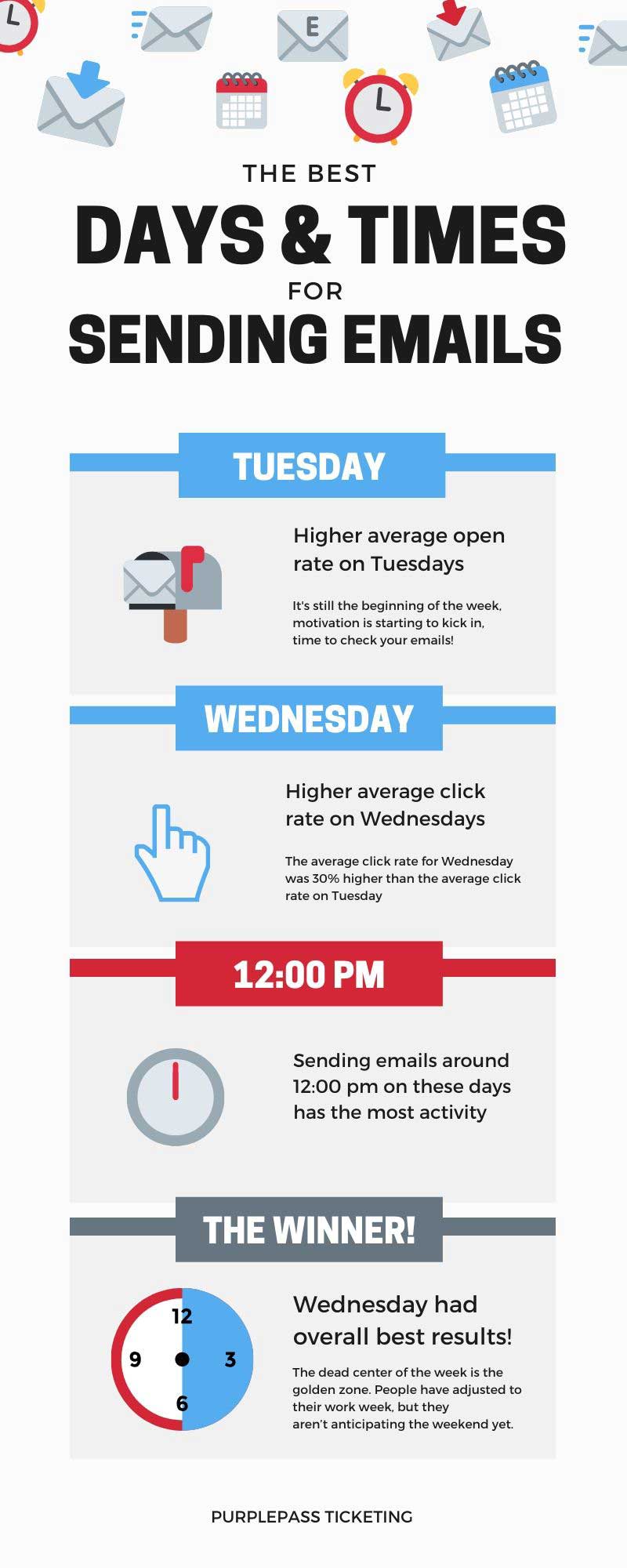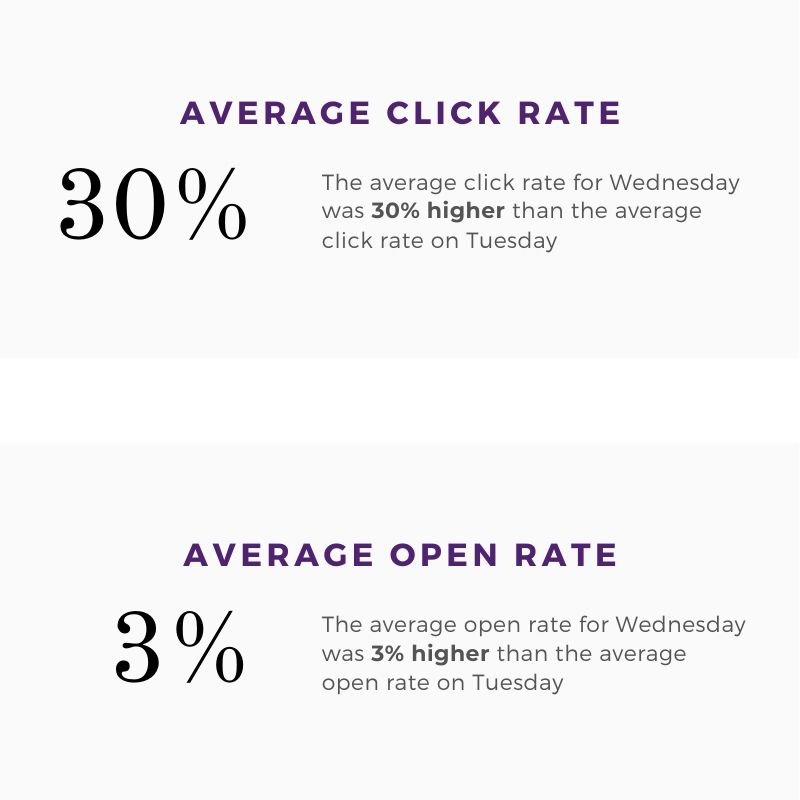The Best Day and Time You Should be Sending Your Event Marketing Emails
Recently, we aggregated our newsletters to better understand our quarterly email marketing metrics. Today, we will share some of these metrics with you.
This post is all about the day and time. What day should you send emails? And what kind of impact does the day of the week have on your overall email metrics?
Let’s check it out!
Understanding email marketing and why we use it

59% of B2B marketers say that email is their most significant revenue source. And the return on email marketing is around $42 per $1 spent. In other words, its effective, cheap, and hyper-measurable.
But we send out emails for reasons that goes beyond the revstream. It helps us keep in touch with our audience, engage with attendees, and build our brand. Numbers rock. But people rock more.
Here’s the interesting thing about emails — everything matters. From your headline to your CTA, every component of your campaign can be maximized to boost engagement and create leads.
But what about when you actually send the email itself?
Why the sending time matters
There are over 293.6 billion emails sent every day. If you want to be one of the few emails that customers actually open, you have to send your email to them when they’re in the “opening” mood.
If you can send that email when they’re actively prepared to read emails, you'll have a much higher chance of converting than if you send it to them when they’re busy.
You may be thinking, “who cares?”, modern email marketing software is automation crazy. So, it doesn’t take much effort to shoot out an email.
Why not just send them one every day?
It will ruin your brand in their eyes; that’s why.
The average marketer sends out 2 emails a week for a reason — that’s the golden zone.
So when should you send them?
Top days for sending emails
The short answer: Tuesday and Wednesday
The long answer: Recently, we collected our internal send time data and compared it with metrics like open rate.
Sure! This has been done before (plenty of times), but we wanted to compare our findings with other people’s findings. Typically, these types of studies (like ours) are done by a single company over a set course of days.
But, to really get an accurate answer on this, you would need to send an absolutely bananas amount of emails to customers in almost every niche.
So how can we be sure it’s Tuesday and Wednesday? Because almost every single study agrees with our findings.
Here's why those days generate the most engagement
It makes sense! It’s the middle of the week. On Mondays, people are wading through work emails.
On Friday, people are auto-piloting through the day until 5 p.m., and on Saturday and Sunday, no one is checking their emails!

The Purplepass email tests
Recently, we compiled metrics for our newsletters over the quarter. Our original plan was to find “the best day of the week” by comparing every day to each other. Instead, we will focus on the meat (i.e., Tuesdays and Wednesdays).
These two days were clear standouts in terms of metric performance. So, we will compare our Tuesday metrics vs. our Wednesday metrics to figure out which day is the best day to send out emails.
Let’s take a brief moment to cover why this is important. You should only be sending a maximum of two emails a week to your customers who subscribe to your newsletter. The number one reason most people (69%) unsubscribe from newsletters is due to being flooded with emails. But that’s just newsletter subscribers.
What about all of the other customers?
If they’re not on your newsletter, you send them no more than3 emails a month, max. Most marketers (35%) send around 2 to 3 emails a month. That’s the money spot. It’s enough to remind your target audience without drowning their inbox in spam.
Our Results
Let’s take a look at the results of our quarterly emails on both Tuesdays and Wednesdays.
- The average open rate for Tuesday was 23.2%. This is somewhat higher than the average open rate across all industries (17.92%)
- The average click rate for Tuesday was 1%. This is somewhat lower than the average click rate across all industries (2.6%)
- The average open rate for Wednesday was 24%. This is somewhat higher than the average open rate across all industries (17.92%)
- The average click rate for Wednesday was 1.3%. This is somewhat lower than the average click rate across all industries (2.6%)

- The average click rate for Wednesday was 30% higher than the average click rate on Tuesday
- The average open rate for Wednesday was 3% higher than the average open rate on Tuesday
What Does it Mean?
Let’s address the elephant in the room. Our click rates are relatively low. Event responders typically point at click rates of 2% to 5%. Ours was around 1.2%. There are a few reasons for this.
For starters, our newsletter emails are hyper-targeted. We typically target subgroups within our newsletter group to deliver the most relevant content. So, newsletters can be about weddings only or school events only.
This fractures our click rates somewhat — since the actual CTA is usually industry-specific.
This is a conscious choice, and our click rates aren’t as important (to us) as our click-to-conversion rates.
Understanding your metric goals
You must sit down with your team and figure out which metrics matter most to you. It’s essential to understand your goals.
While CTR may be crucial metrics for some companies, they can be semi-vanity metrics for others. How you measure your marketing value will depend on your strategy, vision, and overall quarterly goals.
Purplepass email goals
Our click rates are also low due to our content strategy. We’re not aggressive with our CTAs. Our marketing goals involve building brand trust and driving long-term value through relevant content, so we’re not too concerned with how many people click our targeted CTA.
We ARE concerned with open rates. This tells us how many people are actually finding the content useful. It’s especially important to us that this number trends upwards over time (i.e., building reputability.)
More densely packed industries typically have lower click-to-conversion rates, while niche industries usually have higher click-to-conversion rates. Since we send out unique newsletters each day, the actual content itself matters more than the day for us. So, we don’t want to cloud these results with all of these outside variables.
But even with targeted emails, we see a difference between days.
Wednesdays have historically (beyond this quarter) performed better on click rates than Tuesdays. And, both Tuesdays and Wednesdays outperform other days of the week.
For starters, Wednesday has a 30% higher click rate. That’s pretty massive! Again, click rates aren’t the most important metric in terms of our campaign strategies, but the difference is still noticeable.
Now, what definitely matters to us is the open rate. Again, Wednesday shines with a 3% higher openrate. That may not seem like much, but we send out thousands of emails in each batch, so 3% is significant.
What’s the best day of the week to send emails?
Wednesday! That’s right! The dead center of the week is the golden zone.
People have adjusted to their workweek, but they aren’t anticipating the weekend. These results aren’t novel. But they do showcase another example to add to the pile.
Wednesday continues to deliver great results for our newsletter, and we would urge you to measure your daily email metrics across the quarter. With this information, we can try to deliver our most impactful newsletters on the days where they get the most eyes.
Again, we want to reiterate; these results only mean something to you if these metrics are important. Take the metrics that matter most and measure them against days. Remember to think about outside variables that may influence the results.







